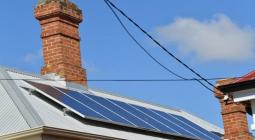Rooftop solar drives up ambient temperatures in urban centres: study
A University of New South Wales, Sydney study, in collaboration with the University of Calcutta, India, has found urban rooftop solar installations can raise daytime temperatures in a given area by up to 1.9 degrees, and lower them at night by up to 0.8 degrees.
A University of New South Wales (NSW), Sydney study in collaboration with the University of Calcutta, India, has found urban rooftop solar installations can raise daytime temperatures by up to 1.9 degrees, and lower them at night by 0.8 degrees.
Focussed primarily on the northeast India city of Kolkata, the research also included comparative studies of rooftop solar sensitivity in Sydney, the USA and Europe, which concluded rooftop solar leads to a significant decrease in urban temperatures at night and increase in the day.
For Sydney, this was a drop of 0.8 degrees C at night and an increase of 1.9 degrees C during the day, which was the largest movement compared to Austin, USA (−0.7 °C to 1.8 °C), Kolkata, India (−0.6 °C to 1.5 °C), Athens, Greece (−0.4 °C to 1.2 °C) and Brussels, Belgium (−0.3 °C to 1.1 °C).
Co-author of the Rooftop photovoltaic solar panels warm up and cool down cities report, UNSW Sydney Scientia Professor Mattheos Santamouris said solar panels are a significant renewable energy technology, but they can change the local conditions of cities when installed on rooftops at scale.
“Understanding these changes is crucial for decision-makers considering city-wide rooftop solar usage and the strategies needed to deploy them effectively,” Santamouris said.
“The heat effect of rooftop solar at 100% rooftop coverage would curb much of the renewable energy benefit. Estimations show that in Sydney, almost 40% of the electricity rooftop solar produces is used to compensate for the overheating impact, in additional cooling load – mainly air conditioning.”
Santamouris said rooftop solar absorbs a significant amount of solar energy, converting some of it into electricity and generating heat in the process.
This is primarily due to the lower albedo (reflectance) of the panels, but also the airflow over the top and underside of the panels, which amplify the heating effect.
“This means, during the peak summer period, the surface can be as hot as 70°C, making it impossible to have a cooling effect on the urban temperature,” Santamouris said.
The transfer of heat at night through radiation leads to the surface temperature of the panels being lower than the urban temperature and lowering the surrounding air temperature.
“This is a crucial benefit as the impact of climactic warming is expected to be felt most acutely during nights, which could warm by around 4 degrees C over the next century, on average,” Santamouris said.
Integrated solutions
Published in the Nature Cities journal the study intends to highlight opportunities for rooftop solar developers to integrate solutions such as reflective materials for rooftops and greenery combinations that balance the benefits with potential drawbacks in urban environments.
Santamouris advocates for the use of hybrid systems that integrate panels with a water-based thermal collection system to absorb excess heat for hot water production.
“It is already possible to cool down the surface of photovoltaics by circulating water and designs that run water behind the panels absorb excess heat and improve efficiency by lowering operating temperatures, while the excess solar energy can be channelled to provide cost-effective hot water,” Santamouris said.
“Highly reflective cool roof materials that bounce heat rather than absorb heat could also be used to boost the energy production of nearby panels while mitigating local urban heating during the day and other heat sinks such as rooftop greenery can also improve efficiency.”
Santamouris said combining solar installations with green roofs or cool roofs can increase the capacity of PVs, by up to 6 – 7% and significantly reduce surface temperatures.
“So, if we wish to continue to implement solar on rooftops, these integrated solutions are something we must seriously consider maximising efficiency and also address the challenges of urban heat,” he said.
Due to the absence of available observational data for rooftop solar panels to model their impact on local climate conditions at a city-scale, the study used mesoscale (weather system) simulations, using weather research and forecasting (WRF) model.
The model was then integrated with multilayer urban schemes, such as a building energy model (BEM) coupled with building effect parameterisation (BEP), that is WRF/BEP + BEM, which accurately captures the energy balance of rooftop solar.
Cover photo: Image: Bernd Dittrich, Unsplash




